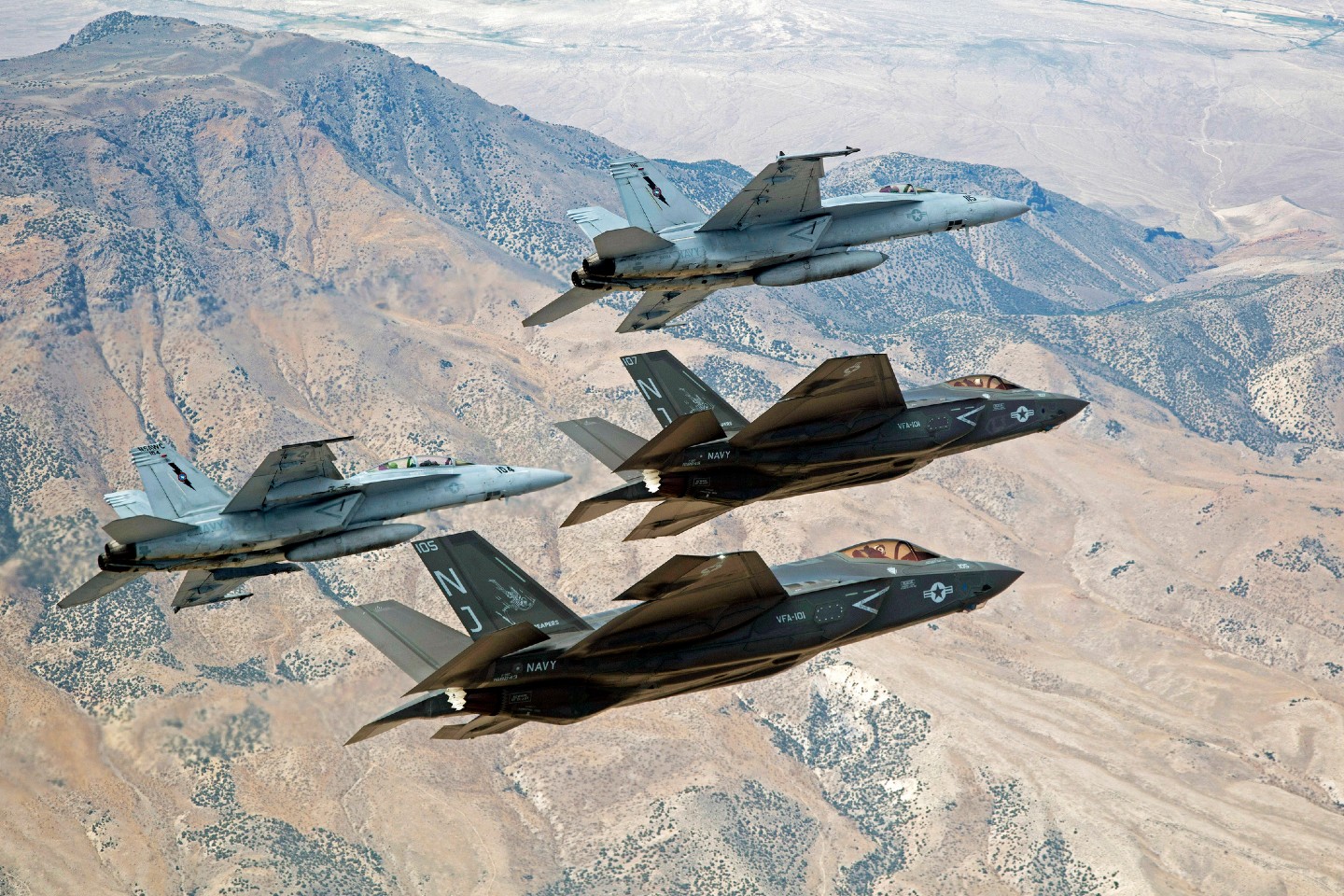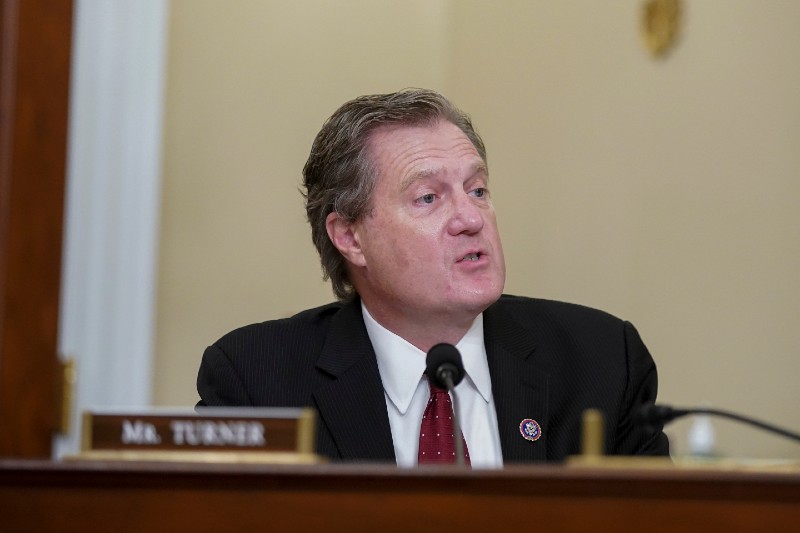
The F-35 joint strike fighter, the most expensive weapons program in history, is finally facing tough questions about its future after chronic delays and cost overruns. But over 150 members of Congress are arguing that the dysfunctional aircraft must keep its high level of funding next year, lest the U.S.—which spends more on its military than the next ten countries combined—fall behind in air superiority to “adversaries like China and Russia.”
On April 28, a bipartisan group of 132 House members put out a letter calling on Congress to continue with F-35 production, procurement, and “robust investment,” citing concerns that any spending reduction would lead to a “capability gap that legacy aircraft or new variants thereof cannot fulfill.”
The letter was led by the four co-chairs of the Joint Strike Fighter Caucus: Reps. John Larson (D-Conn.), Marc Veasey (D-Tex.), Michael Turner (R-Ohio), and Chris Stewart (R-Utah). A group of twenty bipartisan senators followed-up with their own pro-F-35 letter released on May 5.
The cost of the F-35 program has nearly doubled to well over $428 billion since its initial estimate of $233 billion in 2001. Annual defense bills by Congress have pushed tens of billions of dollars into the troubled program even as it suffers from a host of technical maladies, bringing the 50-year operating cost of the F-35 to a gigantic $1.727 trillion of public money authorized. Last year, Congress’ defense budget funded 17 more of the planes than the Pentagon requested.
This year, progressives in Congress are renewing calls for President Biden to significantly reduce the military budget, as they called for last summer during the coronavirus pandemic under President Trump.
Even some hawkish Democratic members of Congress with jurisdiction over the Pentagon budget have joined in advocating for reduced spending on the F-35, which in recent months has seen its official support within the Pentagon begin to wane. The powerful House Armed Services Committee Chair Adam Smith (D-Wash.) criticized the jet’s runaway costs, saying, “I want to stop throwing money down that particular rathole” and suggesting the Pentagon find a way to “cut our losses.” Two Democratic subcommittee chairs said last week that they’re wary of adding any more F-35s than the Pentagon requests to the FY2022 defense budget, which is still being developed as part of Biden’s federal budget proposal. The F-35 is one of a handful of projects mentioned in a Feb. 17 memo by Deputy Defense Secretary Kathleen Hicks as being under Pentagon review for potential cuts in acquisitions.
The House letter to the chairs and ranking members of the House Armed Services Committee and the House Defense Appropriations Subcommittee claims, “The F-35 is the only fighter in production that can produce aircraft in the numbers required to recapture our aging fighter force.” It reads, “The F-35 is a great deterrent for the near peer threats of China and Russia; and as such, we urge the committees to support readiness (sustainment), rate (production ramp) and relevance (modernization) for both the airframe (F-35) and the propulsion system (F135).”
The Joint Strike Fighter Caucus is composed of 27 representatives—seven Democrats and 20 Republicans—who led a similar letter last year calling for continued spending on the F-35 program. The caucus was founded in 2011 to prevent F-35 budget cuts by Rep. Kay Granger (R-Tex.), who was the House’s top recipient of cash from Lockheed Martin’s PAC and employees last cycle at nearly $198,000, and then-Rep. Norm Dicks (D-Wash.), whose top career contributors were mostly military contractors, including Lockheed Martin.
Lockheed Martin, the largest defense contractor in the world, is the prime contractor on the F-35 Lightning II program, which Pentagon watchdogs have tracked has been riddled with structural deficiencies and cybersecurity vulnerabilities. Last year, Lockheed received $72.3 billion from the Department of Defense according to Bloomberg Government, and the company gets around 70% of its revenue from the federal government, making it one of the “pure-play” military contractors. The Pentagon’s former chief weapons buyer, Frank Kendall, told 60 Minutes in a 2014 interview that the faulty F-35 represented “acquisition malpractice.”
Earlier this year, Dan Grazier, a military analyst with the nonpartisan Project On Government Oversight (POGO), told me about Lockheed’s strategies to keep the F-35’s budget sacrosanct. “All the defense contractors use campaign donations to increase their influence on Capitol Hill. Even more important than that, they also spread contracts and subcontracts all over the country,” Grazier said. “The economic impact and the appearance of jobs created among their constituents tends to make members of Congress vocal advocates for particular programs.”
Lockheed’s PAC donated to 25 of the Joint Strike Fighter Caucus members in the 2020 election cycle, not all of whom signed the letter, averaging $7,120, according to Sludge’s review of data from the Center for Responsive Politics (CRP). Eleven of the reps received the per-cycle $10,000 maximum from Lockheed’s PAC, and combined with employee donations, entities affiliated with Lockheed gave over $426,000 to caucus members last cycle. By comparison, to 324 other reps who received PAC contributions from Lockheed, the company’s PAC and employees gave an average of $5,140.

Caucus co-chair Turner was the third-highest House recipient of contributions from Lockheed’s PAC and employees at $64,350, according to CRP. Each of the F-35 letter’s three other organizers—Larson, Veasy, and Stewart—received the per-cycle maximum of $10,000 from Lockheed’s PAC in the 2020 cycle.
Lockheed has been the second-highest career donor to Turner, who represents Ohio’s Tenth Congressional District encompassing much of Dayton, at over $162,000. The defense aerospace industry has been Turner’s third-largest career backer with over $504,000 contributed, according to CRP. For his GOP colleague Stewart, defense contractors have also been top campaign contributors, with Lockheed’s PAC giving a total of $40,000.
Over his career, twelve-term Democratic Rep. Larson has received over $584,000 in contributions from the defense industry, making it his sixth-highest industry donor according to CRP. Weapons contractor Raytheon, which manufactures sensor systems for the F-35, is Larson’s top career donor, with $407,225 given. Lockheed’s PAC and employees have contributed a total of $92,700 to Larson’s campaigns.
Among the letter’s 132 signers are representatives who hold, or recently held, personal investments in Lockheed Martin stock while they advocate for billions of dollars in continued spending on its weapons systems. In the 2019 financial disclosure report for Rep. Kevin Hern (R-Okla.), he discloses holding up to $15,000 in Lockheed through a joint trust called the Hern Family Foundation. On July 27, 2020, he reported purchasing an investment in Lockheed in an amount between $1,000 and $15,000, described as a subholding of Kevin Hern Insurance Trust.
Letter signer Rep. Daniel Meuser (R-Penn.) holds up to $15,000 in Lockheed stock, according to his annual financial disclosure for 2019 with the office of the House clerk.
Rep. Joe Courtney (D-Conn.), another signer, reported that his spouse bought up to $15,000 worth of Lockheed Martin stock on Dec. 31, 2019, and sold up to the same amount of Lockheed stock on Aug. 7, 2020. Courtney had also signed last year’s letter calling for continued F-35 spending while his spouse likely held shares of Lockheed.
Last July, the House and Senate considered an amendment brought by Progressive Caucus leaders Reps. Mark Pocan (D-Wisc.), Barbara Lee (D-Calif.), and Pramila Jayapal (D-Wash.), as well as Sens. Bernie Sanders (I-Vt.), Ed Markey (D-Mass.), and Elizabeth Warren (D-Mass.), that would have cut the Pentagon’s budget by 10% to reallocate funding to healthcare, education, and other needs.
While the amendment did not succeed in either chamber, Pentagon watchdogs described it as the first time in years that cuts to the bloated military budget were the subject of a full House vote. A 2018 POGO report on the Pentagon’s revolving door found that Lockheed, like other top weapons contractors, hires dozens of former senior government officials as lobbyists or company directors to secure Department of Defense contracts.
Progressive advocacy group Win Without War is tracking the members of Congress who publicly support this year’s proposed reduction in the Pentagon budget, and those who supported last year’s amendment to prioritize shifting some $74 billion to pandemic response.
For more military contracting boondoggles, get the Sludge newsletter and follow @Sludge.
See the full list of F-35 letter signers here, starting on page three:
